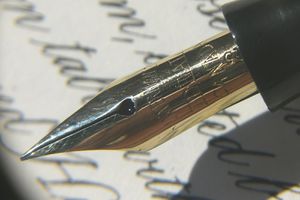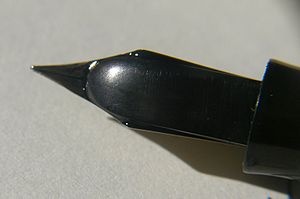How a fountain pen works
The correct functioning of a fountain pen is linked to a harmonious and complex balance of forces whose correct interaction is able to ensure that the ink flows uniform and controlled manner from the pen tank to the paper with only that slight pressure that is obtained by placing the nib on the sheet.
In fact, the forces involved are different: the gravity that pushes the ink to escape from any downward oriented opening, the atmospheric pressure, which prevents any tank with a single outlet hole to empty if there is no way of access that allows the air to enter instead of the liquid (what makes it difficult to quickly empty a bottle when you turn it over), the surface tension", i.e. the characteristic tension of liquids that climb up the walls of a container (the same tension that causes drops to remain attached to the tap or on the surface of a glass).
From the first attempts to create a fountain pen, originating in the mid-1800s, the most critical point was to effectively ensure a uniform flow, which would allow the ink to escape from the tank in controlled quantities, which was sufficient to write on a sheet, but not to stain the pockets or the sheet itself. For this purpose the most complex mechanisms of valves, vents, taps etc. were invented, but the solution was not reached until the end of 1800, when it was understood that it was necessary to rely on the phenomenon of capillarity (one of the consequences of surface tension) in order to solve the problem.
The basic concept on which a fountain pen is based since then is that of a tank from which the ink can only escape through a very small opening. The opening must be small enough to prevent the ink from escaping spontaneously due to the combination of surface tension and atmospheric pressure. Both forces are necessary, as anyone who has found themselves with the pen dripping in the presence of cracks in the tank or a poor seal of a filling system will have noticed.

In fountain pens, this flow control is achieved thanks to the presence of the feeder channel, through which the ink can reach, due to the combined effect of gravity and capillarity, the height of the two wings of the nib. As long as the pen is not used, the surface tension prevents the ink from leaving the feeder and the nib, at least as long as they are correctly mounted and there is no other free passage than that of the feeder channel.
The final stretch of the path is made by the ink by capillarity, passing through the channel in the slit between the two wings of the nib until it reaches the tip, and it is this same capillarity that holds it and prevents it from pouring. But as soon as you place the tip of the nib on a sheet of paper (or another suitable surface), it is the same surface tension, applied this time also to the contact between the tip and the paper, which causes the ink to deposit on the latter and continue to flow as you write through the slit, at least until (in the case of flexible nibs) you press too much widening it too, so as to interrupt the effect of capillarity and the consequent flow of ink.
It is this balance of forces that keeps the flow of ink as long as you keep contact with the sheet, even if this generally does not cause stains because of the low porosity of writing paper that once wet does not absorb more ink on the surface, but as you will have realized anyone who has fallen with a stylus in the pocket after unscrewing from the cap, this is not true for the fabric, which can absorb significant amounts of ink (even from a pen remained open with the tip up).

Il fatto che il flusso d'inchiostro sia legato all'effetto della tensione superficiale è ciò che consente ad una stilografica (oltre a lasciar macchie nelle tasche delle camicie) anche di scrivere verso l'alto, almeno fino a quando non si esaurisce l'inchiostro presente all'interno del canale dell'alimentatore. E' per questo motivo che molti alimentatori hanno delle ulteriori scanalature interne o sorta di piccole sacche che consentono di aumentare questa riserva, che viene reintegrata tutte le volte che, mettendo la penna in posizione verticale, la gravità riporta l'inchiostro del serbatoio in contatto con l'alimentatore. E' sempre per questo motivo che una stilografica, tenuta fino ad un momento prima in tasca con la punta all'insù, è in grado di scrivere immediatamente (se l'inchiostro non si è seccato e se la punta presenta una curvatura adeguata).
Benché tutto questo sia relativamente semplice da descrivere, la realizzazione di un buon funzionamento dipende dal riuscire a far funzionare questo complesso equilibrio di gravità, pressione e capillarità, ed è quindi essenziale che si verifichi un corretto accoppiamento fra pennino ed alimentatore. Ancora oggi capita di trovare stilografiche che presentano problemi più o meno marcati di funzionamento, come difficoltà di avviare la scrittura o perdite di inchiostro.
Fu proprio in questo campo che ebbe luogo l'innovazione introdotta da Lewis Edson Waterman che spesso viene indicata, in maniera infondata, come l'invenzione della prima stilografica. Questi per migliorare la trasmissione dell'inchiostro verso il pennino eseguì una serie di incisioni sull'alimentatore creandovi una sorta di canali su cui l'inchiostro potesse scorrere per capillarità senza però debordare e lasciando spazio sufficiente per consentire all'aria di entrare nel serbatoio della penna. Produsse così uno dei migliori e più affidabili alimentatori del suo tempo, il cui successo è alla radice della esagerata pretesa di aver creato "the first practical fountain pen".
